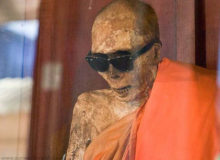Dr. Jamil and Dr. Idries tour the Indian city of Agra where they visit the iconic Taj Mahal, the expansive Agra Fort and the mighty Agra Sheroes; female acid attack survivors who’ve heroically turned tragedy into triumph.

By Drs. Jamil and Idries Abdur-Rahman
Day # 3 in India began promptly at 8AM when our driver for the day met us, as planned, in the hotel lobby. After exchanging pleasantries, we all made our way from the lobby outside to his waiting car. The car, which looked like an early model 2000 or 2001 off white Toyota Corolla was clean both inside and out. It also appeared to be well maintained, safe, and certainly up to the task of transporting us from Delhi to Agra. Agra, a city of 1.7 million people that sits just 3 hours to the southeast of Delhi. Agra, home to the Agra Fort, the Taj and “Agra’s Mightly Sheroes”. Now if you don’t know who the “Sheroes” of Agra are, don’t worry, you soon will. And believe us when we tell you that these young women are nothing short of amazing and inspirational!
Our driver for the day was a fairly tall and slender man of about 6 feet or so. He wore a neatly pressed khaki uniform that looked like something an old Communist Chinese soldier might wear; and his face sported very prominent cheek bones that were supported by a broad and rugged square chin. He had a thick, dark black mustache, and his skin color was surprisingly alabaster. In looking at him, it became immediately clear to both of us that he was not a native Indian. So, as we approached his car, we found ourselves wondering where it was that he was from, and what his story might be? But, before one of us could start to pry, our attention was quickly diverted away from the driver and towards a little boy wearing a blue beanie cap. We both immediately noticed that the rich brown skin on this boy’s face and hands was stained with dirt and grime; and that attached to his blue beanie cap by a short red string was an odd fuzzy appearing yellow ball. This young boy crouching alongside the curb next to our waiting car couldn’t have been more than 6 years old. And as we approached him, his eyes lit up, he quickly leapt from his crouched position to his feet, and he awkwardly began to dance. As his legs began to move vigorously back and forth and side to side, we could hear the pavement rustling beneath his feet. Then, in full “get down” mode and feeling his groove, this little guy next took his right hand, placed it just above his head, and began to twirl the fuzzy yellow ball that was attached to his beanie cap around and around. With the ball making increasingly tighter 360 degree rotations, he next began to rotate his head around and around, doing so in the opposite direction of the twirling ball. With the ball now rotating in one direction, his head rotating in another direction, and his legs flailing about wildly; he next opened his eyes as widely as he possibly could, crossed them while sticking out his tongue, and began to make silly, almost cartoonish looking faces. Sensing from the bemused grins on our faces that he not only had our attention, but also quite possibly would soon have some of our money, this fleet footed little jester, this comedic virtuoso of the Delhi streets then decided to go in for the kill. And so in one fluid motion, he quickly dropped himself to the ground, undulated two times like he was doing the centipede, and then flipped himself backwards up onto his hands. Once on his hands he completed a handstand, all the while managing to keep that little ball on the top of his beanie hat rotating around and around. Needless to say, this little man earned himself a few rupees with that performance.
As we hit the road, we found the streets and highways to be fairly devoid of traffic, and so with little effort or frustration our driver was able to make excellent time. Agra, India’s 19th largest city is approximately 130 miles to the southeast of Delhi. During our 3 hour journey to Agra, we were able to ask our mystery driver who he was and where he was from. Through somewhat broken English he informed us that, as we suspected, he was not from India. Instead he said, he was from Kashmir; a region that lies to the north of India. Kashmir is probably most famous for the Himalaya Mountain range. But Kashmir is also a region of the world that is highly disputed, with three countries, India to the south, Pakistan to the southwest and China to the Northeast, all claiming rights to some parts of the region. Our driver informed us that he immigrated from Kashmir to India in search of a “better life”. He also shared that all of his family, with the exception of his wife and his 2 daughters, still lived in Kashmir; where many of them worked as subsistence Farmers. When he spoke both of Kashmir and of his family still living there, his eyes, which we could see through the rearview mirror, looked for just a few moments as if they were empty and longing for home. But then, likely in large part because of his need to focus on the road ahead of us, he seemed to quickly snap out of his brief melancholy state. Once back with us, he then in a rather resolute and matter of fact sort of way said that his work as a driver in India had given him the ability to provide a “better life” for his children, and that this fact made him “proud”.
Agra
Making just one 10-minute rest stop along the way, we reached Agra in under 3 hours. As we entered Agra city limits, we briefly stopped and picked up the man who would serve as our local tour guide for the day. Continuing on, as we proceeded through the city of Agra, we found that its streets looked more like what a Westerner might expect the streets of a typical Indian city to look like. There were lots of people in the streets. Some of them were walking while others were pulling or pushing carts. There were also lots of animals in the streets. Again, some of them were just walking along while others were pulling carts. We didn’t however see any animals pushing carts through the streets of Agra; though had we seen such a feat of beastly prowess we would have most certainly been impressed. There were also lots of roadside shops lining the streets of Agra, many of which had colorful facades that utilized bright yellows, blues and pinks. There were quite a few open air vendor’s stands as well. The streets and roadways of Agra, being more narrow than the wide boulevards of Mumbai and Delhi, all in all just seemed to be more cozy and more communal than the Indian roads that we had previously encountered. And of course, also traveling up and down the streets and roadways of Agra were lots of mopeds, bicycles and motorized rickshaws; all of which it seemed were testing the unwavering functionality of their horns.
Much like we saw on the streets of Mumbai and Delhi, the streets of Agra also had a large population of women and children, many of whom just seemed to be meandering about, with their clothes in various states of disarray and disrepair. And just like we also encountered in both Mumbai and in Delhi, in Agra, many of these women and children would approach the car that we were riding in as it came to a stop at red lights. Having approached, they would then lightly tap on our car window while holding one of their hands to their mouths; offering the universal gesture of hunger. At the same time, they would then hold their other hand outstretched towards our car window. Frequently, out of feelings of both embarrassment and shame, we both found ourselves trying to avoid eye contact with the people standing just mere feet away from us on the other side of the car door. But when we did make eye contact with these women and children, what we often found were eyes that looked sunken and empty of anything other than sadness, despair and a hopelessness that was frankly pretty damn heartbreaking. Looking in their eyes, we couldn’t help but to wonder what the world looked like to them and what their eyes had seen? And then, when we were finally able to pull our eyes away from their eyes, and when we looked at their outstretched hands, we couldn’t help but to also wonder what those hands had touched? Where those hands had been? What created the scars and the blemishes that marked those hands? And where did the dirt lying beneath the fingernails on those hands come from? Scars and dirt that seemed far more appropriately placed on the hands of an elderly male laborer than they did on the hands of woman or a child. Scars and dirt that added a character to the hands that bore them that seemed wholly out of place when viewed through our western sensibilities.
In addition to the poverty stricken women and children that sadly populate the streets of Agra, Agra was the only city of the three that we visited while in India that also had a large number of cows meandering about, left to live it seemed in relative peace. We had of course seen animals, including cows, walking about along the streets of Mumbai (especially in Dharavi) and Delhi, but Agra was the only city of the three that seemed to have cows that were walking around in abundance, almost everywhere you looked. This is not surprising however when considering the fact that the city of Agra and the state of Utter Pradesh (which is where Agra is located), has a slightly higher percentage of Hindus than does the rest of India. Hindus of course, along with Jains and Sikhs, are largely vegetarian. And Hindus in particular not only do not eat cows, they revere and respect them. As such, they actively take measures to protect cows from harm. So, where one finds lots of Hindus, one will also apparently find lots of free ranging cows.
The Taj Mahal
Along with it’s booming population of free range cows, Agra is also unique among the three Indian cities that we visited in that it also has a large population of free range electric, non-CO2 emitting vehicles that roam it’s streets. These free ranging vehicles are the result of the local government having banned CO2 emitting cars within 0.5 kilometers (i.e. 1/3rd of mile) of the world famous Taj Mahal. It was recently discovered that years of excessive air and water pollution in and around Agra has slowly been damaging the Taj Mahal’s structural integrity; while also compromising its physical appearance. In fact, in 2010 a major European news publication openly lamented that the once pearly white Taj Mahal was appearing more and more yellow. So, in an effort to limit the amount of air pollution that the Taj is being exposed to, a CO2 ban was put into place. The goal of this ban of course being to help preserve the structural and visual integrity of that city’s world famous monument and economic cash cow (no pun intended). Because of this local CO2 ban, as we approached the Taj Mahal, our driver parked our CO2 emitting non-electric vehicle in a remote parking lot that was some distance away from the Taj Mahal. From there, we then traveled to the Taj on a horse driven cart.
After a very green and CO2 free five-minute horse drawn cart ride from the remote parking lot to the Taj Mahal’s main welcoming center, we purchased tickets that would allow us to enter the grounds of the Taj complex. The price of entry was a fairly reasonable 750 rupees (approximately $15.00) for foreign visitors like ourselves, and a VERY reasonable 20 rupees (approximately $0.40) for Indian visitors. After we purchased our “foreigner” entry tickets, we joined a long but quickly moving line, and in no time at all we found ourselves on the grounds of the Taj Mahal complex.
The Taj complex features a large and beautifully manicured garden space that is subdivided by a series of raised parallel and perpendicular pathways. The lattice pattern created by these parallel and perpendicular pathways divides the Taj complex’s large garden space into 16 smaller square garden spaces. At the south end of the Taj complex sits the massive Darwaza. The Darwaza is a covered Redstone gateway that features arches, spires and octagonal towers. It is punctuated by white marble domes. The Darwaza serves as the main entry point to the Taj Mahal complex, and after we entered the Darwaza, the Taj Mahal almost immediately came into view. Then, as we continued making our way through the Darwaza towards the large garden space of the Taj complex, the Taj Mahal began to appear bigger and bigger. And as the Taj Mahal began to appear bigger and bigger, it also began to appear progressively more and more beautiful and more and more awe-inspiring. And then, just as we were about to step beyond the Darwaza, as we passed beneath its final archway, the frame of that archway served to perfectly frame the image of the majestic Taj Mahal that stood immediately in front of us. And as we took a brief moment to appreciate this vista, the goosebumps began to set in as we stood mere moments away from experiencing one of the 7 wonders of the world.
Once beyond the Darwaza, the Taj complex is surrounded to its south, its east and its west by large Redstone walls. At the north end of the complex, situated along the banks of the Yamuna River sits the focal point of the Taj Complex, the grand and majestic Taj Mahal. Flanking the Taj Mahal on its right and on its left are two largely identical appearing Redstone buildings. The Redstone building to the right of the Taj Mahal is a Muslim house of worship, also known as a masjid or a mosque; while the Redstone building to the left of the Taj Mahal, named the Jawab (or the “Answer”) is thought to once have functioned as a guesthouse. Many scholars believe that the Jawab, with its pillars, white marble in-lay and white marble domes (similar in both form and function to the domes found at the complex’s Darwaza gateway) was built simply for the sake of symmetry. They believe that it was built to aesthetically compliment the masjid that stands to the immediate left of the Taj Mahal.
The Taj Mahal was commissioned by the Mughal Emperor Shah Jahan in 1632. It was built to serve as the final resting place for his beloved wife Mumtaz Mahal. Mumtaz Mahal was born Arjumand Banu Begum, the daughter of a Mughal nobleman. Mumtaz Mahal, who was said to be a very beautiful women, would grow up to eventually become Emperor Shah Jahan’s second wife. Mumtaz was said to be so beautiful in fact, that many poets of her day, when describing her beauty would say that even the moon herself would hide in shame when it saw Mumtaz coming. After the lovely Mumtaz and Shah Jahan married in 1612, they had 14 children together. Sadly, 7 of their 14 children died during or immediately following childbirth. And it was during the birth of their 14th child in fact that Mumtaz Mahal herself also died. Following Mumtaz’s death, the great Mughal Emperor Shah Jahan was said to be completely heartbroken and inconsolable. Grieving, Shah Jahan retreated from public life, choosing instead to live in virtual seclusion for 1 year. It was only at the behest of Jahan’s eldest daughters that he eventually emerged from his self imposed seclusion. When he reemerged however, it is said that the once youthful looking Emperor had gone completely gray. Additionally, he was said to have lost a large amount of weight and his face was said to have become worn and troubled looking. He is also said to have reemerged from his seclusion with the posture and the gait of an elderly man.
After emerging from seclusion, still feeling heartbroken and forlorn, the great Emperor was inspired to build the Taj Mahal; a structure that would serve as his moving eternal eulogy to love lost. After commissioning its construction, it took more than 20,000 builders and artisans a total of 22 years to complete the Taj Mahal and it’s surrounding complex. The total cost of constructing the Taj Mahal and it’s surrounding complex topped out at more than 800 million of today’s dollars.
The Taj Mahal was built using white marble adorned with colorful floral in-lays. The style of the mausoleum was in keeping with the classic Mughal architecture of the day; featuring large overriding domes, sharp corners with spires and minarets and large vaulted archways. Interestingly, some believe that the Taj Mahal was not originally intended to be the iconic one-of-a-kind monument that it is lauded for being today. Instead, some believe that the great Mughal Emperor Shah Jahan had planned to build a structure that would have been identical in appearance to the Taj Mahal. This second structure would have been situated just behind the Taj Mahal, on the opposite side of the Yamuna River. This second Taj Mahal, which would have served as Shah Jahan’s own mausoleum after his death, is frequently referred to as the “Black Taj Mahal”. This is because legend has it that this second Taj Mahal was to have been built using black marble. The Black Taj Mahal and the White Taj Mahal would reportedly then have been connected to one and other by a bridge built to span the Yamuna River.
Whether or not the building of a Black Taj Mahal was ever truly something that Shah Jahan had planned to do or not is up for debate. Some scholars argue very passionately that the building of a Black Taj Mahal was indeed something that Shah Jahan had planned to do, while others argue just as passionately that the Black Taj Mahal was never in the offing. What is not up for debate however is the fact that any future building plans Shah Jahan may have had were cut unceremoniously short when his son, Aurangazeb, led a coup to topple his once mighty Father. Much like Shah Jahan had done to his Father, the former Mughal Emperor Jahangir, Shah Jahan’s youngest son did to him; violently wresting away power from him. However, Aurangazeb being the youngest of Shah Jahan’s children only moved to topple his Father’s empire after he had first killed his eldest brother.
Once toppled, Shah Jahan was then imprisoned by his son. And it was in prison that Shah Jahan, the great Mughal Emperor, the builder of the Taj Mahal, the builder of the Red Fort and the builder of the Jama Masjid remained, languishing until the day that he died. While in prison, Shah Jahan was kept in complete and total solitude. The one exception to this came in the form of visits from his eldest daughter, the same daughter who earlier had rescued him from his self-imposed seclusion following the death of his beloved Mumtaz. She was the only person that Aurangazeb would allow to visit Shah Jahan in prison, and she was also the only person that he would allow to bring the former Emperor food.
Legend has it that after imprisoning his Father, Aurangazab cancelled plans for Shah Jahan’s Black Taj Mahal. Perhaps the only kindness that Aurangazeb ever really showed his Father lied in the fact that he imprisoned him in a cell that had a single window. And that single window faced the Taj Mahal. This allowed the once mighty Emperor the opportunity to gaze upon what perhaps was his greatest accomplishment. Plans for a second Taj Mahal ultimately thwarted, Shah Jahan was eventually buried in the “White Taj Mahal” alongside the love of his life, Mumtaz Mahal. And it is there that the two lovers remain, side by side, from now until eternity.
After walking the grounds of the Taj complex, and after taking some of those totally stereotypical “Look at Me Holding the Taj Mahal” photos, we climbed the stairs of the mausoleum before making our way into the building. One benefit we found of paying the inflated “foreigners” entry fee of 750 Rupees was that foreign visitors to the Taj are allowed to enter the building using a shorter line. So literally within 30 seconds of lining up to enter the mausoleum, we found ourselves inside of the fabled building. Once inside, the first thing that struck us was just how dimly lit the interior of the building was. The lighting is kept dim in an effort to preserve both the aesthetic and the structural integrity of the Taj’s white marble floors, walls and cenotaphs. At the center of the mausoleum is an enclosure that is created by a series of white marble barriers that feature a honeycomb design. At the center of this enclosure lies the two cenotaphs that mark where Shah Jahan and Mumtaz Mahal are buried. Because of the Taj Mahal’s thick marble walls and its extremely dim lighting, the interior of the monument (crowds and all) remained pleasantly cool during our entire stay there.
After exiting the Taj Mahal, we walked around the gardens of the Taj complex for another 20 minutes or so before finally leaving Agra’s celebrated UNESCO World Heritage Site. The Taj Mahal has been a UNESCO World Heritage Site since 1983; and it has also been listed among the “New 7 Wonders of the World” since 2007. It should be said that during our travels, we have frequently found that many of the super hyped “world famous” sites and locations that we have been told that we “absolutely must see” don’t in actuality live up to the hype that surrounds them. That however was not the case with the Taj Mahal. The Taj Mahal, a piece of living history that is both majestic and beautiful, exceeded even our wildest expectations; and if the Gods of the Independent Traveler smile upon us again one day, we will most certainly be back to the house that love built.
Once beyond the grounds of the Taj Mahal complex, we made our way back to the remote parking lot where our driver was waiting for us. From there, we drove 10 minutes to a part of town where we had been told that real life Superheros could be found. And not just any real life Superheros, but female Superheroes no less. These female Superheros are known to the locals of Agra as Agra’s “Sheroes”, and they’ve taken up residence in a non-descript little café in the heart of town. So, our next stop was the Sheroes Hangout Café.

Line for the “locals” to enter the Taj Mahal. And yes if you’re wondering, the line does wrap all the way around the building.
The Sheroes Hangout Café
The story surrounding the Sheroes Hangout Café took root in late 2014 when, with help from the Delhi based not-for-profit organization “Stop Acid Attacks”, 5 female victims of severely disfiguring acid attacks banded together to open and staff a local café. The café that these women opened was Agra’s “Sheroes Hangout Café”. When these five acid attack victims, all of who will proudly point out to you that they do not view themselves as victims but rather as survivors, united to open the café, they had two simple goals in mind. Firstly, each survivor wanted a platform from which she could work both individually and collectively to raise awareness about the issue of acid attacks in India. Secondly, each survivor was in search of a way to not only reenter society, but to reenter society in a triumphant, independent and productive manner. In a manner that allowed them to confidently hold their heads up high, for all of the world to see, without feeling shame or embarrassment. In effect, each survivor was in search of a way to heroically, or should we say to “sheroically”, show her face again to the world, without the feelings of shame, fear, guilt or embarrassment that can result after a traumatically disfiguring event. Each of these 5 Sheroes viewed the café, and the public interactions that staffing the café would facilitate, to be a means by which they could accomplish a dignified and wholly purpose drive reintegration into society.
The 5 Sheroes of the Sheroes Hangout Café are Ritu, Neetu, Geeta, Rupa and Chanchal. When we visited the café, the tightly packed first floor of the eatery was almost filled to capacity. We were lucky enough though to spy a table with a few empty chairs tucked away off in a secluded corner. The location of this table turned out to be perfect, as it was just steps away from the cash register where many of the Sheroes were quietly seated. Within moments of having taken our seats, Ritu, a very outgoing and friendly 20-year-old Shero made her way over to our table. She smiled, welcomed us to the café and then handed each of us a menu. A quick look at the cafe’s menu revealed a very curious thing. There were no prices listed next to the items on the menu. When we inquired as to why there were no prices listed and how we would know what it was that we owed for our meals, Ritu told us that the Sheroes Hangout Cafe did not charge set prices for any of the food on it’s menu. Instead she explained, visitors to the Café are only asked to give “whatever it is that they can afford to give”.
The Sheroes Hangout Café has both first and second floor seating areas. The tightly packed first floor seating area is the far busier of the two. In addition to seating, the first floor of the café also features two walls that serve as display areas where paintings, sculptures, books and women’s clothing can be viewed and purchased. The smaller of these two display walls also features a large wall mounted flat screen television. This television features various interviews that the Agra Sheroes have done with media worldwide since the opening of the café. These interviews are played on a continuous loop, and they serve as a nice “introduction” to each of the 5 Sheroes. When we inquired with Ritu about where all of the paintings, sculptures, clothing and books on display had come from, she informed us that a local not-for-profit organization donates all of the items on display; with the exception of the clothes. The clothing on display instead is designed and handmade by Rupa, one of the café’s own Agra Sheroes. All proceeds from the sale of the items on display, including Rupa’s clothing, are used to help offset the café’s operational expenses. Portions of these proceeds are also used to help further the café’s missions of fighting against the acid attacks in India and aiding acid attack victims.
After placing our orders with Ritu, we asked her if we could steal a few moments with her so that we could learn more about her story and about her role at the cafe. Without hesitation she agreed to sit down with us, and so with our local Agra Tour Guide serving as a translator, we set up a table and a few chairs outside of the café. There, we sat down with Ritu; and with little hesitation she began to share the story of her acid attack with us. Ritu’s story, while distressing, is unfortunately all too common in many parts of the Indian Subcontinent. It began with a family property dispute between her and a male cousin. A cousin who was also physically attracted to Ritu, and who had thoughts of one day marrying her. As the dispute became more and more heated, and as it became more and more clear to Ritu’s cousin that Ritu did not share the feelings for him that he had for her, he eventually lashed out; throwing a container of acid in Ritu’s face. As a result of the acid attack, Ritu suffered severe burns on her face and neck. She also unfortunately lost her left eye. To date, Ritu has endured more than 10 reconstructive surgical procedures involving her face and neck, and at the time of our visit she has another procedure scheduled in the coming weeks.
During the course of our conversation with Ritu, she told us that prior to her acid attack she had been an avid volleyball player. In fact, Ritu had even played on the Indian national junior volleyball team before her attack. After the attack however, as a result of both chronic pain and depression, Ritu says that she stopped playing volleyball; and that she had resolved to never play volleyball again. However, we were privileged while at the Sheroes Hangout Café to witness Ritu’s impromptu and unofficial return to the sport of volleyball. This poignant moment came when a pair of Italian Journalists who had also come to the café to interview the Sheroes learned about Ritu’s love of volleyball. When they also learned that Ritu had not played volleyball since her attack, they were moved. So, one of the journalists quickly went out and purchased a volleyball. When he returned to the café later on in the day, he returned carrying the volleyball that he had purchased. With some gentle but persistent encouragement and cajoling, he was then able to convince Ritu to play a one-on-one game of pick-up volleyball with him just outside of the cafe.
When Ritu first began to play volleyball with the Journalist, and as we stood watching the scene unfolding from afar, it felt initially as if Ritu was only playing to be polite and to oblige her guest. It initially really didn’t feel as if her heart was in to the game. And while no physical pain was apparent as she played, some emotional pain certainly did seem to be bubbling right beneath the surface. But then, as the game progressed and as the Journalist and interested bystanders continued to encourage her, Ritu’s intensity and passion began to slowly shine through. At first this intensity and passion was subtle and fairly muted, almost as if they were slightly familiar, but still partially unwelcome guests. But then as the game continued, Ritu’s excitement became very apparent and her competitive nature began to emerge. With her competitive nature emerging and with her excitement building, in no time not only was Ritu playing volleyball again, but she was playing volleyball well and with an unmistakable passion. Beating the Italian journalist handily, and with the intensity of the game building, Ritu’s excitement was clearly reaching a crescendo. And as it did, a smile that resembled an intense ray of sunlight bursting through the clouds on an overcast day broke out across the young Sheroe’s face. At that moment, it seemed that any emotional pain that Ritu may have felt playing volleyball again for the first time since her attack had vanished. At that point, seeing that smile on Ritu’s face reminded us that this young women, for all that she had been through, for all of the suffering, depression and despair that she had endured, was still just a 20-year old young kid with so much life left to lead.
After completing our conversation with Ritu, and after finishing the Coke and the fries that we each ordered, we headed back into the café to speak with Shero and budding clothing designer Rupa. Rupa, like Ritu was very friendly, and she too had a story to tell. Rupa as it turned out was not attacked by a love interest or even by a male (as is typically the case in most acid attacks). Rupa instead was attacked by her own stepmother when she was just 12 years old. As is fairly customary in India, when Rupa was 12, her Father and Uncle had arranged for her to be married to a local boy. When the final details for the marriage had been completed and the plans were all set to move forward; Rupa’s Stepmother, angered by the prospect that she would no longer have 12-year-old Rupa in the home to help her out with the domestic chores, lashed out violently. She threw acid in Rupa’s face. Her goal being to disfigure Rupa severely enough that her prospective Husband and his family would no longer want her. If they no longer wanted Rupa her Stepmother reasoned, then Rupa would be forced to stay in her family’s home. Unfortunately, part of Rupa’s Stepmother’s calculus was correct, and her prospective husband no longer wanted to marry her following the disfiguring acid attack. But part of Rupa’s Stepmother’s calculus was also incorrect, as Rupa ultimately did not stay in her family home after the attack. Today Rupa lives independently, and she proudly designs and tailors both traditional Indian and Western clothing that is sold at the Sheroes Hangout Café.
After speaking with Rupa, we lastly took a few moments to meet and to speak with Neetu. Both Neetu and her Mother Geeta (who was busy cooking in the kitchen at the time of our visit) are also acid attack survivors. They were attacked approximately 24 years ago by Geeta’s Husband (Neetu’s Father). The attack occurred while Geeta, Neetu (then 3 years old) and Neetu’s then 1-year old Sister were all sleeping in a shared family bed. Geeta’s Husband (the children’s Father) attacked them all with acid as they slept. What motivated him to attack his wife and children is still unclear, but both Neetu and Geeta suffered severe facial burns that compromised their vision. Neetu’s 1-year old Sister on the other hand unfortunately died as a result of her injuries. With domestic abuse being unfortunately commonplace in India, their attacker (who was also the head of their household) was not only not prosecuted for his crimes against them, but Geeta and Neetu, with nowhere else to go after the attacks, were forced to continue living with him for many years to follow. Today, in large part because of the financial and social independence that the Sheroes Hangout Café has provided for both of them, they now both live independently in a safe and supportive environment that is also far far away from their tormentor.
Acid burns are so devastating because they typically cause what is referred to as a “coagulation necrosis”. Coagulation necrosis of tissue basically results in the utter, largely irreversible destruction of that tissue. A great deal of this destruction results from the tissue’s proteins being degraded and then unable to properly regenerate. This leaves the tissue severely and irreversibly damaged. When the eyes are involved in an acid attack, as is often the case since most acid attackers throw the acid in their victims faces, the tissue damage that results can be even more devestating. This is because when acid comes into contact with the eyes, it not only causes coagulation necrosis of the eyes, but it also typically causes opacification of the normally transparent corneas. The corneas are the thin layer of protective tissue that covers and protects the fronts of the eyes. When the corneas become opaque and cloudy, this basically disrupts a person’s ability to see.
The Indian National Crime Records Bureau estimates that over 1000 acid attacks occur in India every year. 70% of acid attack victims in India are women and more than 50% of these female victims are attacked by spurned or rejected love interests. This troublingly high number of acid attacks in India is thought to result in part from the fact that caustic acids (many of which are used to clean rusted tools) can be bought in India for as little as 50 cents a liter. Furthermore, no limitations are placed on who can buy these caustic acids or on how much they can buy. It is of note however that in 2013, in response to the epidemic of acid attacks in India, the Indian legislature enacted a law requiring that any person buying caustic acids be made to show ID before the purchase can be completed. Furthermore, the law also now requires that the identities of those buying a caustic acid be registered; and section 326A of the Indian Penal Code further ensures enhanced punishment for all acid attackers. The minimum prison sentence for an acid attacker in India is now set at 10 years, while the maximum sentence is now set at life in prison.
Unfortunately, we were only able to spend about an hour with the Sheroes of the Sheroes Hangout Café; but it was likely the single best one hour that we spent with anyone, anywhere in India. These 5 survivors of the Sheroes Hangout Café are a true testament to the strength of the human spirit. They remind us all that hope and happiness can spring forth vigorously from the darkest depths of despair and sadness; and that our lives, and our circumstances can sometimes truly be what we make of them.
The Agra Fort
After leaving the inspirational Sheroes Hangout Café, we next made our way by car to the Agra Fort. The Agra Fort, designed in a manner very similar to the Red Fort in Old Delhi, features large and imposing Redstone walls, towers and defensive bastions. However, while the Agra Fort is large and boasts impressive Mughal architecture that is similar in many ways to the architecture seen at the Red Fort; the Agra Fort, at only 94 acres, is roughly 1/3rd the size of the Red Fort. This smaller size makes leisurely exploration of the Agra Fort quite a bit easier. In addition, the Agra Fort’s relative ease of exploration is further ensured by the surprisingly small number of “local guides” milling about outside of the fort, offering to share their “expertise” for a small fee. The Red Fort in Delhi on the other hand has, at what times can feel like an endless stream of these oft-times very persist and frequently intrusive “local guides”, ready it feels to pounce at every turn.
The Agra Fort was commissioned by the Mughal Emperor Akbar in the year 1565. Like the nearby Taj Mahal, the Agra Fort is also a UNESCO World Heritage Site. Like the larger Red Fort in Old Delhi, the Agra Fort has 4 gates. One gate is located on each of the fort’s four sides. And the similarities between the Agra Fort and the Red Fort don’t stop there. Two of the Agra Fort’s four gates, the Delhi Gate and the Lahori Gate, share names with gates found at the Red Fort. The Agra Fort’s Delhi Gate, which is located along it’s western wall and which faces the city of Agra, is the most elaborate of the fort’s four gates. It once featured a large wooden drawbridge that crossed a moat that housed crocodiles. This drawbridge served to connect the Delhi Gate’s inner and outer entrances to one and other. The inner entrance of the Delhi Gate was (and still is) guarded by two large stone elephants. These elephants stand ready to “defend” the fort against any and all intruders who might try to enter. Unfortunately, because the Indian armed forces still uses parts of the Agra Fort for modern day military purposes, the Delhi Gate is off limits to the public. So, instead of entering through the Delhi gate, we entered the Agra Fort through the less elaborate, but still very impressive Lahori Gate.
Once within the Redstone walls of the Agra Fort, we were almost immediately taken by the acropolis’ ornately designed buildings, it’s lush garden spaces and it’s finely maintained stone walkways. While this UNESCO World Heritage Site offers a lot to see and appreciate, the most exquisite of the buildings that we encountered while at the fort were the Sheesh Mahal (the Glass Palace), the Diwan-i-Khas (the Hall of Private Audiences), the Khas Mahal (the White Marble Palace) and the Nagina Masjid (the Gem House of Worship). Also, because of the fort’s more manageable size, we were able to easily see all of these monuments without feeling the least bit rushed.
The Sheesh Mahal (aka the Glass Palace) is a dwelling that is thought by some to have once functioned as both a summer retreat, and as an imperial bath house for the great Mughal Emperor Shah Jahan. Shah Jahan commissioned the Sheesh Mahal’s construction in the year 1631. The walls of the Sheesh Mahal were made from extra thick cuts of marble. Extra thick marble walls were used in the Sheesh Mahal’s construction so that the central chambers of the Glass Palace would remain well insulated. By remaining well insulated, the interior of the Sheesh Mahal would maintain a cool temperature, even during the hottest of hot Agra summer days. Additionally, the two large central chambers of the Sheesh Mahal, chambers where marble tanks and fountains were constructed to provide for both a hot and a cold water supply for bathing, could only be reached via narrow indirect passageways. By making the central chambers only accessible through these narrow indirect passageways, very little natural lighting could actually reach them. This meant that the lack of direct sunlight reaching the central chambers also helped to keep them cool during the warm summer months. Because of this lack of natural lighting however, artificial lighting was (and still is) needed to illuminate the central chambers of the Sheesh Mahal. And it is the use of this artificial lighting within the central chambers, when employed, that adds an almost ethereal dimension to the Sheesh Mahal’s already magnificent ambience. This added dimension is created when the artificial lighting used to illuminate the central chambers interacts with, and dances seductively off of, the mirror mosaic walls that line the chambers. This dance creates a unique kaleidoscopic effect that is almost otherworldly in its brilliance.
After spending a few stolen moments loitering about in the refreshingly cool central chambers of the Sheesh Mahal, we next made our way to the Nagina Masjid. The Nagina Masjid, or the “Gem House of Worship”, was constructed using a pure white marble. The construction of the Nagina Masjid was commissioned by the Mughal Emperor Shah Jahan. Jahan had the marble sanctuary built strictly for use by the women of the Emperor’s court. The Nagina Masjid features a large area for worship that is partially subdivided into three smaller areas by a collection of rectangular marble pillars. These pillars also serve as the primary support structures for the masjid’s 14 notched archways. On the Nagina Masjid’s marble floors are multiple darkly colored etchings. These etchings collectively create the appearance of there being rows of prayer rugs on the sanctuary’s floor. Rugs that are just waiting for the ghosts of female Mughal aristocrats from a majestic era by-gone to come and to pray.
During the height of the Mughal Empire, just a stone’s throw away from the Nagina Masjid, was a bustling bazaar. The proximity of this bazaar to the Nagina Masjid was no coincidence. The bazaar was placed close to the masjid to make it easy for the women of the Emperor’s court to stand on the masjid’s balcony after prayers. From there, with a simple point of their privileged fingers, they could designate the items that they wanted their loyal attendants to go to the bazaar and to purchase for them. While the Nagina Masjid is one of the smaller structures on the grounds of the Agra Fort, its quaintness is really appealing. Standing among the sanctuary’s marble columns and arches and beneath it’s three decorative domes, you can’t help but to imagine what the life of a privileged Mughal woman must have been like.
After the Nagina Masjid we next visited the Diwan-i-Am and the Diwan-i-Khas. The Diwan-i-Am is a space that was used by the Mughal aristocracy to meet with members of the general public; while the Diwan-i-Khas is a space that was used by the Mughal aristocracy to receive visiting royalty and dignitaries. Both of these spaces were very similar to the Houses of Public and Private Audiences that we saw while at Old Delhi’s Red Fort. After taking a few moments to tour each of these houses, we left the Agra Fort and made our way back to Delhi in our early model off white Toyota Corolla. We arrived back in Delhi after sunset, a little road weary and a lot hungry. So you can imagine just how two famished, self-avowed pigs chose to satisfy their ravenous appetites. By hitting a buffet of course…..duh!!!!
The Extraordinarily Frustrating and Profoundly Disappointing Buffet
Back at the hotel, we headed down to one of the Radisson Blu’s two restaurants. There we had what turned out to be an extraordinarily frustrating and thusly profoundly disappointing “all-you-can eat” dinner buffet. Now how can a buffet be extraordinarily frustrating and profoundly disappointing you might ask? After all, is it even possible for two unabashed, shameless, self-avowed pigs like ourselves to ever find any “all-you-can-eat” buffet to be frustrating and disappointing? Shockingly friends yes, yes it is possible for two pigs like us to be frustrated and disappointed by an all-you-can-eat buffet. Yes, it is possible for a buffet, for the last bastion of shameless culinary hedonism, to be both frustrating and disappointing. This is possible when the purveyors of said all-you-can-eat buffet choose to put on a production that takes the control over what you can eat and when you can eat it out of the hands of the diner. After all, let’s be real people. You go to a buffet because you just want to grab as many plates of whatever it is that you want to grab whenever it is that you want to grab it. You go to a buffet because you prefer to wait on yourself rather than being waited upon. You go to a buffet because you want to be in control of your culinary experience.
Unfortunately, the Radisson Blu has a slightly different take on what constitutes an all-you-can-eat buffet. And their abstract, perplexing, down right un-American take on the all-you-can-eat buffet was frustrating and disappointing. We know, there go those 2 words again, frustrating and disappointing, but damn it we were frustrated and disappointed!!! Now the folks at the Radisson Blu can be forgiven for their un-American take on the all-you-can-eat buffet since after all, well, the purveyors of the buffet aren’t American. But we digress, and we don’t want to miss the bigger picture here. So what in the heck was so frustrating and disappointing about the Radisson Blu’s all-you-can-eat dinner buffet you might be wondering? Well for one, you couldn’t get your own food. When we walked into the restaurant we immediately located a stack of plates. We being ready to chow down with little control and with no shame each grabbed a plate from this stack. After grabbing our plates however, we stood where we though that the food should be, but where no food was, looking and feeling utterly confused. Sensing our confusion no doubt, one of the restaurant staff members came over to us and quietly said “please sit down, we will bring the food to you”. “Huh” we thought??? And then silently, with our eyes and with our mannerisms, we told this young man, “Sir we are outraged. We were led to believe that this was an all-you-can-eat buffet. We’ve been duped. we’ve been bamboozled. Show us the door at once!!!” But instead of showing us the door (I guess he couldn’t read our eyes afterall), he just took our plates from our hands and showed us to a table. He then said “please sit down and relax, we will bring your food to you”. At that moment we said “no thank you, we thought that this was a buffet. We will just eat elsewhere”. However, after hearing this, the young man showed that he wasn’t going to be easily dismissed or thwarted; and so he said “no, please sit down. You will enjoy this I promise you”. “Oooook, well I guess we’re not leaving then” we thought. And so as instructed to do, we sat down.
After sitting down two servers came and asked us what we would like to drink. We both ordered Cokes, and in no time we both had Cokes. The servers then brought each of us an empty plate and informed us that the appetizers would soon be arriving. As promised about 30 seconds later they returned with appetizers. One vegetable samosa and one piece of tandoori chicken each. They placed these appetizers on our plates and then they stood there, right by our sides, as we each ate the appetizers. “Don’t you fellas have somewhere to go, maybe something to do” we thought to ourselves. Apparently though, they didn’t. And so after completing the appetizers that they had brought us, something that took us all of about 60 seconds mind you, the servers (still at our sides) then asked if we liked the appetizers? We did like them, and so we answered “yes, they were very good, thank you”. Each server then smiled at us and then smiled at each other before asking “would you like some more”? And as they asked this, we then realized just how this whole production was going to go down. They would bring us small amounts of food. Initially appetizers and then entrees. They would then stand there right by our sides as we ate these small amounts of food. When we finished these small amounts of food, they would then ask “was it good”? Since most of the food was in fact good, we would then reply “yes, it was very good, thank you”. They would then smile at us, smile at each other and then ask “would you like some more”? And so on and so on the production went. The purveyors of the Radisson Blu’s “all-you-can-eat buffet it seemed were interested in putting on a culinary show of sorts. A production that involved the elaborate and staged “presentation” of the food. We did not want that however. We did not like that. We found that to be both frustrating and disappointing. We got tired of sitting there with two servers at our side. We got tired of them asking us whether or not we liked the meager amounts of food that they had just placed on our plates. We got tired of them asking if we wanted more. We got tired of them then bringing only SMALL amounts of more. The whole production just seemed so over-the-top and needlessly cumbersome. It felt like the restaurant was trying to make something that is normally very simple (i.e. the all-you-can-eat buffet) elaborate and fancy. It felt like they were just trying too hard, and the result was a big frustrating and disappointing fail. But hey, the Independent Traveler takes things in stride, right? Even if that means being subjected to the gross, sacrilegious, un-Godly and wholly un-American perversion of the previously sacred all-you-can-eat buffet. Disappointed and frustrated (we just had to get those two words in one more time) we completed our meals before retiring to our room for the night.

 June 16, 2017
June 16, 2017
































































 May 19, 2018
May 19, 2018 





